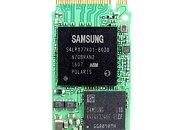Tuesday, September 13th 2016

Samsung Readies SSD 960 EVO Based on New "Polaris" Controller
Samsung is giving finishing touches to a new line of PCI-Express solid-state drives (SSDs) that offer performance that matches or beats the current SSD 950 Pro series, at lower price-points, the 960 EVO. These drives leverage the company's 48-layer 3D-VNAND flash memory, and the new "Polaris" SSD controller by Samsung, to serve up performance that beats the 950 Pro. Samsung could transfer some of the cost-savings in using the inexpensive flash standard to the consumer, highlighted by the company's decision to brand these drives "EVO."
Tom's Hardware discovered that the Samsung PM961 drives are analogous to the 960 EVO, featuring identical components - the "Polaris" controller, and 48-layer TLC 3D-VNAND flash chips . These drives come in capacities of 128 GB, 256 GB, 512 GB, and 1 TB, with sequential transfer rates of up to 3000 MB/s reads, with up to 1150 MB/s writes; up to 360,000 IOPS 4K random-read, and up to 280,000 IOPS 4K random-write. The 960 EVO will ship in M.2 NGFF-2280 and PCIe add-on card form-factors, with PCI-Express 3.0 x4 bus interfaces. The drives will support the NVMe protocol.
Source:
Tom's Hardware
Tom's Hardware discovered that the Samsung PM961 drives are analogous to the 960 EVO, featuring identical components - the "Polaris" controller, and 48-layer TLC 3D-VNAND flash chips . These drives come in capacities of 128 GB, 256 GB, 512 GB, and 1 TB, with sequential transfer rates of up to 3000 MB/s reads, with up to 1150 MB/s writes; up to 360,000 IOPS 4K random-read, and up to 280,000 IOPS 4K random-write. The 960 EVO will ship in M.2 NGFF-2280 and PCIe add-on card form-factors, with PCI-Express 3.0 x4 bus interfaces. The drives will support the NVMe protocol.

48 Comments on Samsung Readies SSD 960 EVO Based on New "Polaris" Controller
P.S. What's the difference between Pro and EVO again? I'm not sure how this is supposed to be faster AND cheaper.
Frankly if the lower capacity ones can get close to advertised specs in practice, it would make a good medium for dedicated page file/swap/etc drive, with respect to store/clear cycles wich might factor a lot considering.
vs
Intel 600P 512GB = 195€
→ The SM961 is the much better bargain.
- Not everyone lives in a first world country where you can download these games in less than 10 minutes. because they have 100Mbps / 1Gbps Fibre connections.
- Simply; it's annoying to swap between games, hell, sometimes I play FPS games like Overwatch, Battlefield, CSS, after that, maybe World of Warcraft to chill after a FPS shooter and other single player games. I really don't want to download something first that I have decided to play on a whim. It's easier to download everything on large storage space and click "Play" when I want to play a said game. This point and above go hand in hand and can make it extremely annoying if circumstances don't allow it.
- Swapping large data/games around like this will kill your drive in no time flat, don't pass the 5 year warranty mark (in my case) and don't get to collect a new drive.
It makes a massive difference between load times when it comes to larger games if you are using both a SSD for a system/page file drive and a dedicated SSD game drive. My problem is; after all this time we have had the technology, the $/GB has remained ridiculous. Data size keeps increasing but we are being limited by these idiotic things and it's come to a point for me where it's absurd and annoying.Windows should simply say the drive is operating in read-only mode and all the changes needed for operation of the OS are being stored in memory. This way you could still copy data off the system to other drive and then throw it away. With power cycle bricking (which is what 100% of drives does at the moment afaik) it's just useless.
And all of that tlc and ~500 cycles before cells die is complete bullshit. SLC cells are made the same way as TLC (just different way of interpreting the data inside the cell). The issue here is, that after 500-1000 rewrites, cell is not reliable enough to accurately store the charge, needed for 3 bit per cell. Such cell could operate in MLC or SLC mode just fine for quite some time.
It's preprogrammed to brick itself after it reaches the rated p/e of the flash.
The "Pro" drives from Samsung (or in the OEM naming scheme, the SM*** drives) are more or less the same in performance to the EVO series (or PM*** for the OEM variants), maybe a tad faster but not by much. BUT they usually have a much higher endurance (total bytes written to the drive before it wears out) due to better flash chips and as such do often come with a much longer warranty period. This warranty thing usually don't apply to the OEM drives of course.
The 850Pro for instance has 10 years warranty, wheras the 850Evo only has 5 years. For the 950Pro it also was only 5 years, but this was probably because there never was a 950Evo released.